
The genus Tadarida has 9 or more species of free-tailed bats divided into two subgenera, with the first of these containing seven species spread across the Old World. Four species occur exclusively in Africa including Madagascar while two more species occur in central Papua New Guinea, and western and southern Australia, respectively.
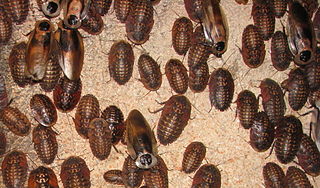
Giant cockroaches, or blaberids, are the second-largest cockroach family by number of species. Mostly distributed in warmer climates worldwide, this family is based on the American genus Blaberus, but much of the diversity is also found in Africa and Asia.

Blattidae is a cockroach family in the order Blattodea containing several of the most common household cockroaches. Notable species include:
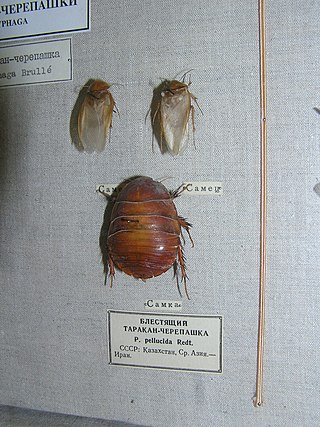
Corydiidae, previously known as Polyphagidae, is a family of the order Blattodea (cockroaches). Many are known as sand cockroaches. The family is divided into five subfamilies, comprising some 40 genera. One prominent species is the desert cockroach, Arenivaga investigata.

Cockroaches are insects belonging to the order Blattodea (Blattaria). About 30 cockroach species out of 4,600 are associated with human habitats. Some species are well-known as pests.

Supella is a genus of cosmopolitan and wild cockroaches, in the family Ectobiidae: originating from Africa and the Arabian Peninsula.

The death's head cockroach is a species of cockroach belonging to the family Blaberidae. It is often confused with the discoid cockroach, Blaberus discoidalis, due to its similar appearance. It is distinguished by jet black cloak-like marking on its wings and a skull-shaped, amber/black marking on its pronotum. The name death's head comes from the markings on the top of the pronotum: "cranii", which is Latin for "of the head", and "fer", meaning "carry" or "carrier". Due to their unique appearance and certain characteristics, they make an easy to care for pet or display insect for entomologists and hobbyists.
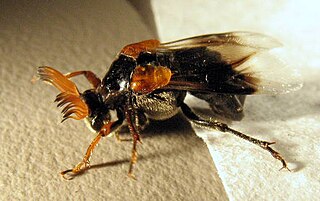
Ripiphoridae is a cosmopolitan family of some 450 described species of beetles sometimes called "wedge-shaped beetles". Ripiphoridae are unusual among beetle families in that many species are hypermetamorphic parasitoids, an attribute that they share with the Meloidae. Members of the family differ in their choice of hosts, but most attack various species of bees or wasps, while some others attack cockroaches or beetles. Many species of Ripiphoridae have abbreviated elytra, and flabellate or pectinate antennae.
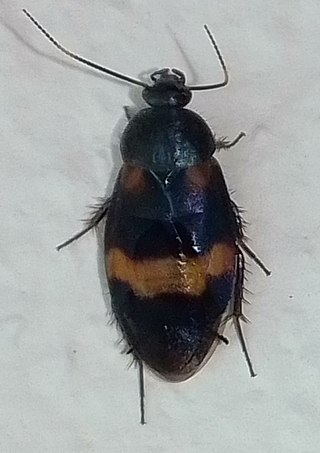
Holocompsa is a genus of hairy sand cockroaches in the family Corydiidae. It is the only genus in the subfamily Holocompsinae.

Diploptera, occasionally called beetle cockroaches, is a genus of blaberid cockroaches in the monotypic subfamily Diplopterinae. Cockroaches of this genus resemble beetles, with hardened tegmina and cross-folded hindwings. They live in tropical forests in South China and Southeast Asia, and Pacific islands including Hawaii. They are viviparous cockroaches and are therefore used for insect endocrinological studies.

Ectobius is a genus of non-cosmopolitan cockroaches once thought native to the Old World and described by Stephens in 1835, belonging to the family Ectobiidae, subfamily Ectobiinae. The discovery of 4 ectobius cockroaches in Colorado dating to 49 million years ago suggests the genus actually originated in North America. This genus has been subject to a number of revisions.

Lucihormetica is a South American genus of giant cockroaches from the family Blaberidae, collectively referred to as glowspot cockroaches. It has been anecdotally reported that the thoracic spots of males are bioluminescent, but detailed research has been unable to conclusively prove this, although evidence for autofluorescence exists. The genus includes both relatively common and rare species: For example, L. verrucosa is relatively common and sometimes kept in captivity, while eight of the remaining species only are known from a single specimen each.

Gromphadorhina is a genus of large, flightless cockroaches from southern Madagascar; they are typical of the tribe Gromphadorhini and common in the pet trade. In the older literature, the name is sometimes misspelled as Gromphadorrhina.

Eublaberus is a genus of South American cockroaches in the subfamily Blaberinae, identified by Morgan Hebard in 1920.
Blabericolidae is a family of parasitic alveolates in the phylum Apicomplexia.
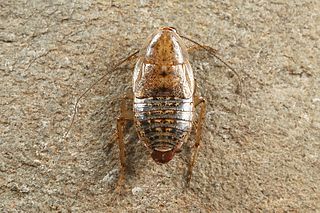
Capraiellus is a genus of non-cosmopolitan cockroaches in the family Ectobiidae.

Polyphaga saussurei is a cockroach species distributed throughout Central and South Asia and the northeastern Caucasus. It is found in terrestrial habitats, and mainly lives in dry conditions. It can serve as a domestic pest in its natural habitat, although this is not incredibly common.
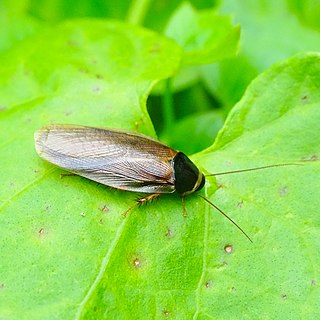
Pycnoscelus is a genus of cockroaches in the family Blaberidae. Species in the genus Pycnoscelus are recorded from India, China and SE Asia.

Corydiinae is a subfamily of the order Blattodea (cockroaches). Many are known as sand cockroaches. The subfamily, comprising about 20 genera, contains half the genera in Corydiidae. One prominent species is the desert cockroach, Arenivaga investigata.

















